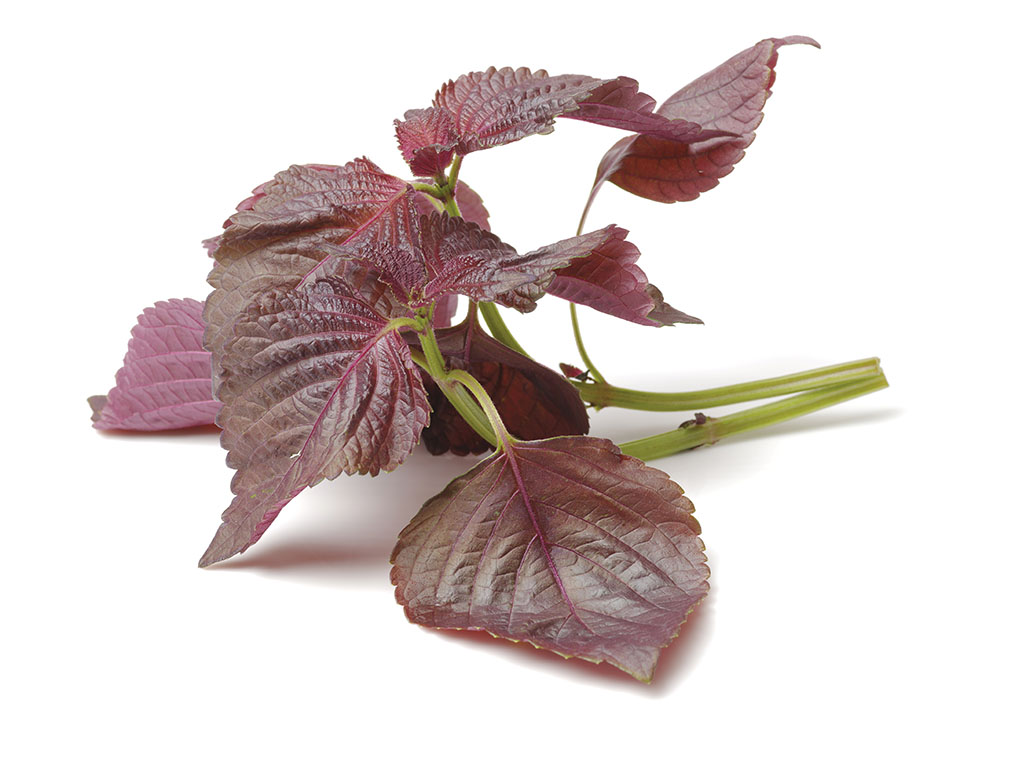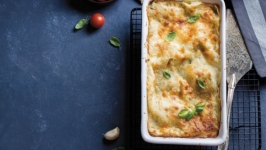The Herb of Many Names
Perilla (frutescens var. crispa) goes by so many names that any self-respecting gardener could be forgiven for not re- membering a third of this plant’s monikers. In Japan, the plant is called shiso, and in Korea, perilla mint. In Chinese traditional medicine, it is known as “zi su,” and in North America it’s been called beefsteak plant, Joseph's coat, wild coleus and rattlesnake weed.
An herb in the mint family, green-leaf perilla is arguably the most common variety closely followed by red-, bicolour- and ruffled-leaf varieties.
One of the earliest historical records of perilla can be traced back to the Western Han Dynasty. According to the Compendium of Materia Medica, the leaves can be eaten with vegetables, brined with sour plums or salt as a side dish, or boiled into soup for drinking. Considered one of the 50 fundamental herbs in Chinese Traditional Medicine, perilla was sometimes used to treat stomach and lung ailments. In Japan, the oil extracted from perilla leaves, was until the 16th century, used as a fuel for oil lamps. Until recently, perilla was not known by North American gardeners for its culinary attributes. The plant was most commonly found in the home garden as a bedding plant growing alongside geraniums and the colourful coleus plant.
“For the home gardener, perilla is an easy-to-grow plant,” says Ana Dushyna, a Vancouver-based garden speaker and expert specializing in herbs and medicinal plants.
Perilla seeds can be started indoors in early spring, a couple of weeks after the last frost, or sown outdoors in late spring as soon as temperatures are a steady 8 C during the day and night.
“Seeds require overnight soaking in lukewarm water,” Dushyna says. “This will help them sprout faster.” If starting indoors, use equal parts sterilized seed-starting mix and perlite. “When sowing the seeds, do not use a thick layer of soil, only a bit,” she recommends.
The seeds will germinate in fewer than three weeks. Once the indoor seedlings are established and are approximately seven to eight centimetres tall, they can be hardened off in preparation
for outdoor planting. Take the seed tray outside for elongated periods each day until it can finally be left out overnight. Perilla grows quickly, reaching its maximum height of 60 centimetres in early summer. All varieties enjoy full sun to partial shade. It is, however, a plant fussy about water. Too little and it will dry out; too much and the roots can become waterlogged and rot. Before watering the plant, a great rule of thumb is to use a water metre to check moisture levels in the soil. Growing in any soil type, perilla will adapt according to sandy, loamy or clay soils.
“If you would like to have a more fragrant plant, grow in poor soil; if less fragrant, grow in rich soil,” Dushyna says.
The plant’s unique minty smell attracts pollinators and does double duty acting as a detractor of pests such as garden mice, who find the smell repelling.
Hardy to minus -1 C, perilla may survive in southern British Columbia during a mild El Niño winter, but as a general rule, it’s considered an annual plant that dies back in the autumn. In late fall, harvest the seed pods the plant produces. Save and replant them in the spring for a continuing harvest of fresh perilla.
Throughout the growing season, harvest the plant’s leaves, as needed. Green perilla leaves are often described as being a mix between mint and basil while red perilla has the same distinctive fresh mint flavour tinged with cinnamon, cumin, cilantro and even a slight anise flavour.
Perilla leaves are ideal as a flavouring for tempura, salads, food wraps and even cocktails. The flower spikes can be cooked in soups or deep fried, and the seeds traditionally are roasted and ground with salt, chillies and tomatoes to make a savoury side dish or chutney. One of the most unique uses of green perilla leaves is in a cocktail. To make a shiso-yuzu mojito, tear four or five shiso leaves into large pieces and add to a shaker. Add one teaspoon of brown sugar, two ounces of vodka, two cups of club soda and the juice from a quarter of a lime. Muddle the mixture and pour it into a glass. Garnish with a perilla leaf and enjoy.
Shiso tempura
Recipe by Matt Hodder
If you enjoy making tempura, shiso is a great addition to your usual repertoire. The firm leaves make them easy to dip and the flavour is a great compliment to other vegetables you are cooking.
Shiso leaves, washed and dried
Tempura batter
1 egg
1 cup ice water
¾ cup cake or all-purpose flour
¼ cup cornstarch
3 cups neutral oil for frying
Tentsuyu (tempura dipping sauce)
1½ cups dashi or vegetable stock
2 tablespoons light soy sauce
2 tablespoons mirin
Salt and sugar, to taste
Combine all of the tentsuyu ingredients in a small saucepot. When the mixture reaches a simmer, turn off the heat. Season to taste. Reserve.
In a pot, heat the oil to 350 F, making sure the oil is a couple of inches in depth and the pot is deep enough for deep-frying. While the oil is heating, make the batter. It’s important that the batter is the last component assembled before frying, to ensure a light, crisp tempura.
In a bowl, beat the egg, then add the ice water and mix thoroughly. Add flour and cornstarch in one shot. Using chopsticks or a small whisk, mash or chop at the batter, making sure not to overmix — do not stir. Over- mixing develops the glutens and results in a bread- like, doughy, finished product. Instead, it should be runny and lumpy, with visible bits of unmixed flour in the batter and around the edge of the bowl.
Dip the shiso leaves into the tempura batter, then drop them in the hot oil. Be careful not to crowd the pot. Cook the tempura for two to three minutes or until the batter is golden and has floated to the top.
Remove the tempura from the pot and place it on a drying rack or paper towel. Serve immediately with tentsuyu.






